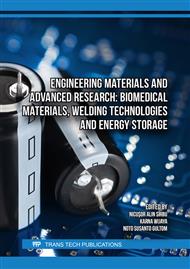[1]
M.P. Zuleta, P. Björnbom, A. Lundblad, Effects of Pore Surface Oxidation on Electrochemical and Mass-Transport Properties of Nanoporous Carbon. Journal of The Electrochemical Society. 152, 2 (2005) A27.
DOI: 10.1149/1.1843772
Google Scholar
[2]
C. Xiang, M. Li, M. Zhi, A. Manivannan, N. Wu, Reduced graphene oxide/titanium dioxide composites for supercapacitor electrodes: shape and coupling effects. Journal of Materials Chemistry. 22, 36 (2012) 19161–19167.
DOI: 10.1039/c2jm33177b
Google Scholar
[3]
B.Xu, S.Yue, Z.Sui, X. Zhang, S. Hou, G. Cao, Y. Yang, What is the choice for supercapacitors: graphene or graphene oxide. Energy & Environmental Science. 4, 8 (2011) 2826–2830.
DOI: 10.1039/c1ee01198g
Google Scholar
[4]
W. Wang, S. Guo, I. Lee, K. Ahmed, J. Zhong, Z. Favors, F. Zaera, M. Ozkan, C.S. Ozkan, Hydrous Ruthenium Oxide Nanoparticles Anchored to Graphene and Carbon Nanotube Hybrid Foam for Supercapacitors. Scientific Reports. 4, 1 (2014) 1–9.
DOI: 10.1038/srep04452
Google Scholar
[5]
A.V. Fulari, M.V.R. Reddy, S.T. Jadhav, G.S. Ghodake, D.Y. Kim, G,M. Lohar, TiO2/reduced graphene oxide composite based nano-petals for supercapacitor application: effect of substrate. J. Mater. Sci. Mater. Electron. 29, 13 (2018) 10814–10824.
DOI: 10.1007/s10854-018-9146-5
Google Scholar
[6]
A. Zhai, L. Zhang, T. Du, B. Ren, Y. Xu, S. Wang, J. Miao, Z.A. Liu, Review of carbon materials for supercapacitors. Materials & Design. 221 (2022) 111017.
DOI: 10.1016/j.matdes.2022.111017
Google Scholar
[7]
P. Konnerth, D. Jung, J.W. Straten, K. Raffelt, A. Kruse, Metal oxide-doped activated carbons from bakery waste and coffee grounds for application in supercapacitors. Materials Science for Energy Technologies. 4 (2021) 69–80.
DOI: 10.1016/j.mset.2020.12.008
Google Scholar
[8]
S. Acharya, S. Sahoo, S. Sonal, J.H. Lee, B.K. Mishra, G.C. Nayak, Adsorbed Cr(VI) based activated carbon/polyaniline nanocomposite: A superior electrode material for asymmetric supercapacitor device. Composites Part B. 193, 107913 (2020) 1-13.
DOI: 10.1016/j.compositesb.2020.107913
Google Scholar
[9]
R. Kayiwa, H. Kasedde, M. Lubwama, J.B. Kirabira, The potential for commercial scale production and application of activated carbon from cassava peels in Africa: A review. Bioresour Technol. Rep. 15 (2021) 100772.
DOI: 10.1016/j.biteb.2021.100772
Google Scholar
[10]
Y.S. Su, A. Manthiram, Lithium−sulphur batteries with a microporous carbon paper as a bifunctional interlayer. Nat. Commun. 3, 1166 (2012) 1-6.
DOI: 10.1038/ncomms2163
Google Scholar
[11]
S. Guo, J. Peng, W.L.K. Yang, L. Zhang, S. Zhang, H. Xi, Effects of CO2 activation on porous structures of coconut shell-based activated carbons. Appl. Surf. Sci. 255, 20 (2009) 8443–8449.
DOI: 10.1016/j.apsusc.2009.05.150
Google Scholar
[12]
T. Koji, Kemiri (Aulerites Moluccana) and Forest Resource Management in Eastern Indonesia, An Eco-Historical Perspective, International Symposium: "The Beginning of the 21st Century: Endorsing Regional Autonomy, Understanding Local Cultures, Strengthening National Integration", Hasanuddin University, Indonesia, (2000) 5-23.
Google Scholar
[13]
M. Lempang, W. Syafii, G. Pari, Structure and Components of Charcoal and Activated charcoal from Candlenut Shell. J. Forest Prod. Res. 29, 3 (2011) 278–294.
Google Scholar
[14]
M. Maher, S. Hassan, K. Shoueir, B. Yousif, M.E.A. Abo-Elsoud, Activated carbon electrode with promising specific capacitance based on potassium bromide redox additive electrolyte for supercapacitor application. Journal of materials research and technology. 11 (2021) 1232-1244.
DOI: 10.1016/j.jmrt.2021.01.080
Google Scholar
[15]
S.S.A. Syed-Hassan, M.S.M. Zaini, Optimization of the preparation of activated carbon from palm kernel shell for methane adsorption using Taguchi orthogonal array design. Korean J. Chem. Eng. 33, 8 (2016) 2502–2512.
DOI: 10.1007/s11814-016-0072-z
Google Scholar
[16]
Y. Huang, X. Gao, X. Han, Z. Guang, X. Li, Controlled synthesis of three-dimensional porous carbon aerogel via catalysts: effects of morphologies toward the performance of lithium-sulfur batteries. Solid State Ion. 347 (2020) 115248.
DOI: 10.1016/j.ssi.2020.115248
Google Scholar
[17]
M. Jayachandran, S.K. Babu, T. Maiyalagan, N. Rajadurai, T. Vijayakumar, Activated carbon derived from bamboo-leaf with effect of various aqueous electrolytes as electrode material for supercapacitor applications. Mater. Lett. 301 (2021) 130335.
DOI: 10.1016/j.matlet.2021.130335
Google Scholar
[18]
A.R. Tobi, J.O. Dennis, Activated carbon from composite of palm bio-waste as electrode material for solid-state electric double layer capacitor. J. Energy Storage. 42 (2021) 103087.
DOI: 10.1016/j.est.2021.103087
Google Scholar
[19]
X. Bo, K. Xiang, Y. Zhang, Y. Shen, S. Chen, Y. Wang, M. Xie, X Guo, Microwave-assisted conversion of biomass wastes to pseudocapacitive mesoporous carbon for high-performance supercapacitor. J. Energy Chem. 39 (2019) 1–7.
DOI: 10.1016/j.jechem.2019.01.006
Google Scholar
[20]
R.A.L. Sobrinho, G.R.S. Andrade, L.P. Costa, M.J.B. Souza, M.G.P Anne, I.F. Gimenez, Ordered micro-mesoporous carbon from palm oil cooking waste via nanocasting in HZSM-5/SBA-15 composite: Preparation and adsorption studies. J. Hazard. Mater. 362 (2019) 53–61.
DOI: 10.1016/j.jhazmat.2018.08.097
Google Scholar
[21]
S. Shi, Y. Liu, Nitrogen-doped activated carbons derived from microalgae pyrolysis by-products by microwave/KOH activation for CO2 adsorption. Fuel. 306 (2021) 121762.
DOI: 10.1016/j.fuel.2021.121762
Google Scholar
[22]
M.J. Livaniivani, M.G. Ghorbani, H.M. Mehdipour, Preparation of an activated carbon from hazelnut shells and its hybrids with magnetic NiFe NiFe2O4 nanoparticles. New Carbon Mater. 33, 6 (2018) 578-586.
DOI: 10.1016/s1872-5805(18)60358-0
Google Scholar
[23]
N.H.N. Azman, M.S. Mamat, M. Nazir, L.H. Ngee, Y. Sulaiman, Graphene‐based ternary composites for supercapacitors. Int J Energy Res. 42 (2018) 2104–2116.
DOI: 10.1002/er.4001
Google Scholar
[24]
M.U. Rani, K. Nanaji, T.N. Rao, A.S. Deshpande, Corn husk derived activated carbon with enhanced electrochemical performance for high-voltage supercapacitors. Journal of Power Sources. 471, 228387 (2020) 1-10.
DOI: 10.1016/j.jpowsour.2020.228387
Google Scholar



